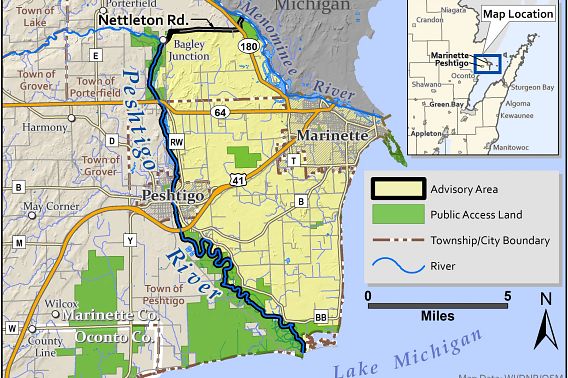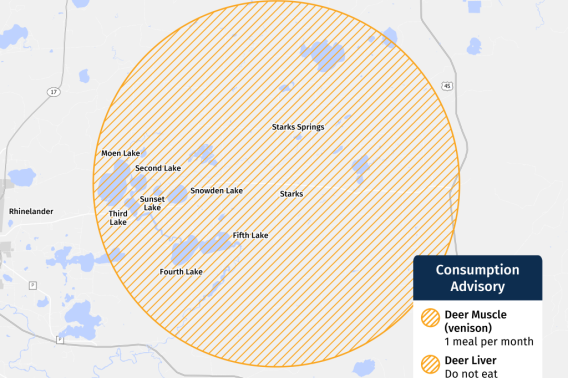Safely Eating Venison
Wisconsin has a rich hunting tradition, and wild game is a sustainable, lean source of healthy protein. Whether in the woods and fields or on the water, outdoor adventure and hopefully a tasty, hard-earned meal await hunters in our state. Still, some precautions should be considered before consuming wild game.
Advisories on lead ammunition and consumption from areas where wild animals have known exposure to contaminants are in place to protect hunters and their families safe from possible exposure to harmful substances. This page provides information to keep in mind before planning your next hunt.
Lead in Venison
Use caution when consuming venison harvested with lead ammunition.
Lead ammunition can break apart when it hits a deer, leaving behind tiny fragments in the meat. These fragments are often too small to see or feel while chewing.
Most lead fragments are found in the meat near the wound channel, but some can spread farther. Trimming extra meat around the wound channel can help reduce your risk.
Grinding or processing venison can spread any fragments throughout the meat. This means that ground venison from a deer shot with lead ammunition may carry a higher risk of lead exposure.
Lead is toxic to humans, even in very low amounts. Children under six years old and pregnant women face the highest risk of health problems if exposed.
Hunting with lead-free bullets, such as copper ammunition, is the best way to eliminate any risks from lead ammunition.
If you do use lead ammunition, there are still steps you can take to lower your risk:
- Use ammunition that fragments less, such as:
- Bonded bullets.
- Controlled expansion bullets.
- Shotgun slugs.
- Muzzleloader bullets.
- Practice shooting your firearm to understand how your ammunition performs.
- Place your shot carefully:
- Avoid hitting bone. This can cause a bullet to fragment more.
- Only shoot when you have had a good rest for your firearm.
- Wait until the deer is broadside and still.
- Don't shoot at running deer.
- Always trim a distance away from the wound channel.
- Discard any meat that:
- It is bruised or discolored.
- Contains hair, dirt, bone fragments, or grass.
- Minimize rinsing around the wound channel. Rinsing can spread lead fragments.
- Choose whole cuts of meat over ground meat if you don't know how the meat was harvested.
- Avoid consuming internal organs, which can contain extra lead from heart or lung shots. Internal organs can also expose you to other environmental contaminants, like PFAS.
Additional Documents
- DATCP Safe Venison Handling
- Lead In Venison: What Hunting Families Should Know
- MN DNR Lead information for deer hunters
- MI DHSS Lead Bullets and Venison - What Every Hunting Family Should Know
- Bullet Fragmentation Study: Supplementary Data
This is an important issue that will continue to be monitored. For a more comprehensive review of lead in venison, visit the Wisconsin Department of Health Services.
Deer PFAS Advisories
Consumption Advisory For Deer Near the Town Of Stella
The DNR and Department of Health Services (DHS) have issued new PFAS-based guidance for the consumption of deer harvested within a 5-mile radius of the Town of Stella town hall. The new guidance for consuming harvested deer is one meal per month for muscle tissue and "Do Not Eat" for liver.
For context, the DNR began investigating the PFAS build-up in local deer due to the community's high interest in PFAS contamination near the town of Stella. To sample deer, the DNR asked hunters within a 3-mile radius to donate muscle and liver samples from their harvests during the 2024 hunting season. A total of 11 deer were sampled, and the DNR and the DHS analyzed the results.
Testing showed elevated PFAS levels in the muscle of (venison) deer harvested from this area. Because of these findings, the DNR and DHS have issued a one-meal-per-month PFAS-based consumption advisory for deer muscle (venison) in a 5-mile radius around the town of Stella.
Sampling results also showed significant PFAS levels in deer liver tissues. The liver filters chemicals from the blood, and chemicals like PFAS can accumulate in the liver over time. These findings suggest that eating liver from deer in this area will likely result in significant PFAS exposure. DHS and DNR recommend not eating liver harvested from deer within the advisory area.
For more information on PFAS, visit the DHS's PFAS website. The DNR's Environmental and Health Impacts of PFAS webpage provides information on the effects of PFAS consumption.
Consumption Advisory For Deer Liver Harvested In the Marinette Area

Per- and polyfluoroalkyl substances (PFAS) are artificial chemicals used in industrial processes and manufactured products. They don't break down easily and can remain in the environment, where people can be exposed to them for a long time.
Due to local interest, the Wisconsin Department of Natural Resources studied PFAS levels in deer at the JCI/Tyco Fire Technology Center, 2700 Industrial Parkway, in Marinette. Twenty deer were harvested and measured for PFAS levels in muscle (venison), heart and liver tissues.
For those who eat venison from deer harvested within the five-mile advisory area, the muscle (venison) and heart of white-tailed deer are not likely to result in significant PFAS exposure, according to our findings. Therefore, a PFAS-based consumption advisory is not warranted for the muscles or hearts of deer from this location.
However, our findings suggest that eating liver from deer in this area will likely result in significant PFAS exposure. The liver filters chemicals from the blood, and some substances, like PFAS, can accumulate in the liver over time.
DHS and the DNR recommend not eating liver harvested from deer within the advisory area.
PFAS can accumulate in our bodies slowly over time through repeated exposure. High levels of PFAS in the body harm human health, especially that of pregnant women. High levels of PFAS in the body may:
- Increase cholesterol levels;
- Decrease in how well the body responds to vaccines;
- Increase the risk of thyroid disease;
- Decreased fertility in women;
- Increase the risk of high blood pressure or pre-eclampsia in pregnant women; and
- Lower infant birth weights.

